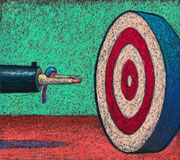Buy this car. Try our juicy burgers at 10% off. Watch our action-packed show tonight. Drink a cold beer. Read Knowledge at Wharton regularly.
These aren’t exactly examples of scintillating advertising copy. But the messages are short and to the point — and in that respect they are the kinds of ads that Clear Channel Communications is hoping sponsors will buy on its radio stations.
Clear Channel, which owns more than 1,200 stations and is the nation’s largest radio company, has begun selling five-second, two-second and even one-second spots in the hope that cost-conscious marketers will find them attractive, according to The Wall Street Journal. Clear Channel is hoping to benefit from increased ad sales in the face of heightened competition for ad dollars from a variety of new and old media. But how much can an advertiser communicate in a five-second “adlet” or a two- or one-second “blink,” as these super-short ads are called?
Faculty members in Wharton’s marketing department and a media expert at Penn’s Annenberg School for Communication say such ads cannot be relied upon to be effective in establishing a brand or introducing a new product. But they may be quite useful in heightening awareness of an existing brand in the minds of listeners or viewers.
Adlets and blinks are part of a broader shift in a fragmenting media industry as broadcasters try to adapt to new technologies — such as TiVo and music and video downloading — that allow listeners and viewers to evade traditional advertising. In addition, many listeners simply change stations when long commercial breaks, known as “pods,” begin.
On its website, Clear Channel discusses how it has cut down on the number of ad minutes per hour and on the number of ads in each commercial pod in an attempt to create a better experience for commercial-weary listeners and a better advertising environment. “When the music stops, the listening shouldn’t,” says the website, adding: “With fewer commercial breaks, shorter pods and shorter, more creative copy, spots get more share of voice and higher recall.”
According to Wharton marketing professor Patricia Williams, “there is an increasing recognition that consumers just tune out ads. So the likelihood that you’re going to keep consumers engaged for a 60-second or 30-second ad is minimal, especially on radio and TV when people will channel-flip as soon as the ads appear. There’s also recognition that a good amount of the time advertisers are buying in a traditional 30- or 60-second ad might be a waste anyway because consumers aren’t paying attention.”
Joseph Turow, a professor and associate dean for graduate studies at Annenberg, agrees. “So many people are using iPods and going on the web to get music,” he says. “And radio stations are seeing that a lot of people are leaving because they can’t stand the number of ad minutes. So Clear Channel is trying to cut down [on ad minutes] to get more [listeners].”
Radio and TV advertisers typically focus on the number of consumers reached with a message and the number of times those consumers are reached, or frequency, for a given amount of spending, according to Wharton marketing professor David Reibstein. Over the decades, advertisers have turned to ever-shorter radio ads in an attempt to get a bigger bang for the buck. Sixty-second spots, which were once the norm on TV and radio, eventually gave way to 30-second and 15-second spots.
“When advertisers went from 60-second to 30-second commercials and from 30-second to 15-second commercials, they said, ‘Wow, I can reach twice as may people with shorter spots,'” says Reibstein. “But that ignored the question of whether a shorter ad has the impact of a longer ad. Clearly that’s not the case. However, if all you want to do is get your name out there, shorter is fine. But if you have to explain something, or visually show something more complex and with more content, you can’t do it with a little blip.”
Reibstein likens an adlet or a blink to ads and corporate logos painted on vehicles in a stock-car race. Sponsors of auto racing can measure the number of fans they reach every time a car goes around a racetrack, as well as the number of home viewers who see the cars on TV. The advertiser does indeed reach millions of people in this fashion, but the impact is not the same as that of a 60- or 30-second ad, says Reibstein.
Burma Shave Revisited?
It is noteworthy that Clear Channel is taking a prominent role in offering short radio ads, according to Wharton marketing professor David Schmittlein. The reason: Clear Channel is also a leading player in the billboard industry — a business where consumers typically get only a fleeting glance at an advertising message as they zip along.
“Two seconds is a long time to be not looking at the road,” Schmittlein notes. “A lot of the tricks of the trade in making five-second or two-second spots effective are going to be the same in the audio domain as what outdoor advertisers face.”
People tend to think of a billboard as a one-shot advertisement on a highway that tells motorists to get off at the next exit for McDonald’s. But the billboard business is more complicated than that. What advertisers buy is a set of locations that will cover, say, 80% of drivers in certain regions over the next 30 days, says Schmittlein. The ad agency buys that space on a 30-day minimum, and they usually buy a number of exposures keyed to the size of the population in the region. Each billboard is owned by many different individuals and companies, so advertisers hire billboard ‘consolidators’ like Clear Channel, which puts together packages of billboard buys using information about traffic flows.
Research has shown that billboards work best when their text is limited to three to five words because the message is exposed to motorists for only one-half of a second to two seconds, according to Schmittlein.
What is the best way for an advertiser to take advantage of super-short ads on either radio or TV? The Wharton marketers say five- or two-second ads may work well in reinforcing an existing brand with a high level of consumer awareness or announcing an upcoming event at an established retailer or a new product by a well-known manufacturer.
“Ads that remind people to ‘Do something now’ and basic brand-awareness ads work great on billboards,” Schmittlein says, and probably they will on radio, too. Here are some examples: A computer company is introducing a new desktop model and uses a short ad to direct consumers to its website, where they can learn all about the model’s functionality. A supermarket chain informs viewers that their stores will be open all day on an upcoming holiday. A TV network urges listeners to tune in tonight to the season premiere of last year’s top-rated crime drama. A chain of convenience stores tells consumers during a July heat wave that its popular iced drink is available at a reduced price.
Say It with a Song
Several of those interviewed say adlets or blinks that use melodies, sound effects or well-known taglines — or a combination of the three — can be especially effective in keeping a brand or product top-of-mind. Examples of notable audio signatures include the Southwest Airlines ‘ding’, the “Intel Inside” tinkling audio tag, Fox’s thumping theme music for National Football League games, or Coca-Cola’s famous jingle, “It’s the Real Thing.”
“Advertisers can use short ads to broadcast a very quick image and a brand identification, like a logo or package, and a sound associated with your brand,” says Williams.
Schmittlein says advertisers buying short spots may also find it useful to leave off part of their message so that consumers can complete the message in their minds — if consumers already have been primed to do so. Schmittlein recalls a 1960s ad campaign for Chiffon margarine which featured a female voice singing: “If you think it’s butter but it’s not, it’s Chiffon.” After the ads appeared for a period of time and left the entire jingle permanently entrenched in people’s memories, the advertiser took a new tack by running the ad with an incomplete jingle: “If you think it’s butter but it’s not … ” Listeners completed the catchy tune in their heads by filling in the blank — “… it’s Chiffon.”
One thing to avoid in scheduling super-short ads on radio or TV is clutter. According to Schmittlein, airing too many brief ads back to back would be a disservice to all the advertisers because their individual messages could get lost in the jumble. “It’s just like billboards: if you have 10 billboards lined up next to one another, that’s a problem,” he says.
Another risk with five- and two-second ads — but particularly the two-second spots — is that listeners and viewers may miss them altogether. “If it’s easy for consumers to avoid a 30-second message by changing the station, it’s really easy to tune out a two-second message,” suggests Williams.
At the same time, though, Williams says a two-second ad may work well, not in spite of its brevity, but because of it. When an ad comes on the air, it takes most people a couple of seconds to change the radio station or TV channel, and even TiVo recordings jump back a bit when programs are replayed. So viewers may see a couple seconds of commercial content they did not necessarily wish to view.
Despite some potential pitfalls, short ads can, by and large, be put to effective use. “In the past, advertisers always tried to do something catchy in the first few seconds of a 60- or 30-second ad,” says Williams. “These short ads mean they can’t ever do that, but the short ads will have people’s attention for two or five seconds. So advertisers should try to use them. The trick will be to look for some level of effectiveness. After they have tried the ads, advertisers have to figure out the appropriate metrics and measure what the ads seem to have accomplished.”
Annenberg’s Turow, who says he doesn’t know whether short ads will catch on, likens adlets and blinks to product placements in TV shows: Advertisers will pay handsome sums to studios even if their beer can, cereal box or automobile appears only for a few seconds. “The whole idea of whizzing past people is part of what product placement is about. When a show has a product there and the camera pans away from it — and these short ads are not all that different — it’s a fleeting mention of a product that’s designed to reinforce a kind of memory retrieval system.”


